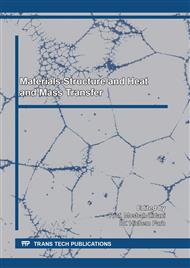[1]
D. Toboła, W. Brostow, K. Czechowski, P. Rusek, Improvement of wear resistance of some cold working tool steels, Wear, 382 (2017), 29-39.
DOI: 10.1016/j.wear.2017.03.023
Google Scholar
[2]
J. A. Szumera, The tool steel guide. Industrial, First ed., Industrial Press Inc, New York, (2003).
Google Scholar
[3]
R. A. Mesquita, Tool Steels: Properties and Performance, Taylor & Francis Group, Boca Raton, (2017).
Google Scholar
[4]
T. Nykiel, T. Hryniewicz, Transformations of carbides during tempering of D3 tool steel, J. Mater. Eng. Perform., 23 (2014) 2050-2054.
DOI: 10.1007/s11665-014-0979-7
Google Scholar
[5]
Ö. N. Doğan, J. A. Hawk, J. H. Tylczak, Wear of cast chromium steels with TiC reinforcement, Wear, 250 (2001) 462-469.
DOI: 10.1016/s0043-1648(01)00635-4
Google Scholar
[6]
N. Mole, I. Naglič, R. Šturm, Time and temperature dependent softening of H11 hot-work tool steel and definition of an anisothermal tempering kinetic model, Mater. Today, 22 (2020).
DOI: 10.1016/j.mtcomm.2019.100744
Google Scholar
[7]
H. Demir, S. Gündüz, M. A. Erden, Influence of the heat treatment on the microstructure and machinability of AISI H13 hot work tool steel, Int. J. Adv. Manuf. Technol., 95 (2018) 2951-2958.
DOI: 10.1007/s00170-017-1426-3
Google Scholar
[8]
M. Momeni, S. Kheirandish, H. Saghafian, J. Hedjazi, M. Momeni, Effects of heat treatment on mechanical properties of modified cast AISI D3 tool steel, Mater. Des., 54 (2014) 742-747.
DOI: 10.1016/j.matdes.2013.09.002
Google Scholar
[9]
B. Skela, M. Sedlaček, F. Kafexhiu, B. Podgornik,Wear behaviour and correlations to the microstructural characteristics of heat treated hot work tool steel, Wear, 426 (2019) 1118-1128.
DOI: 10.1016/j.wear.2018.12.032
Google Scholar
[10]
P. Timotius, C. Zhan, R. Maziar, N. Thomas, A. Dominique, The Effect of Heat Treatment Atmosphere on Hardening of Surface Region of H13 Tool Steel, J. Mater. Sci. Chem. Eng, 1 (2013), 20-29.
Google Scholar
[11]
W. Prudente, J. F. C. Lins, R. P. Siqueira, S. N. Priscila, Microstructural evolution under tempering heat treatment in AISI H13 hot-work tool steel, Int. J. Eng. Res. Appl, 7 (2017) 67-71.
DOI: 10.9790/9622-0704046771
Google Scholar
[12]
B. Skela, M. Sedlaček, B. Podgornik, Microstructure and Heat Treatment of Hot Work Tool Steel: Influence on Mechanical Properties and Wear Behaviour, Key Eng. Mater., 767 (2018), 196-203.
DOI: 10.4028/www.scientific.net/kem.767.196
Google Scholar
[13]
F. Deirmina, N. Peghini, B. AlMangour, D. Grzesiak, M. Pellizzari, Heat treatment and properties of a hot work tool steel fabricated by additive manufacturing, Mater. Sci. Eng., A, 753 (2019) 109-121.
DOI: 10.1016/j.msea.2019.03.027
Google Scholar
[14]
N. S. Kalsi, R. Sehgal, V. S. Sharma, Cryogenic treatment of tool materials: a review, Mater. Manuf. Processes, 25 (2010) 1077-1100.
DOI: 10.1080/10426911003720862
Google Scholar
[15]
K. Amini, S. Nategh, A. Shafyei, A. Rezaeian, Effect of deep cryogenic treatment on the properties of 80CrMo12 5 tool steel, Int. J. Miner. Metall. Mater., 19 (2012) 30-37.
DOI: 10.1007/s12613-012-0511-8
Google Scholar
[16]
A. Akhbarizadeh, M. A. Golozar, A. Shafeie, M. Kholghy, Effects of austenizing time on wear behavior of D6 tool steel after deep cryogenic treatment, J. Iron. Steel Res. Int., 16 (2009) 29-32.
DOI: 10.1016/s1006-706x(10)60023-4
Google Scholar
[17]
K. Amini, A. Akhbarizadeh, S. Javadpour, Cryogenic heat treatment - a review of the current state, Metall. Mater. Eng., 23 (2017) 1-10.
DOI: 10.30544/238
Google Scholar
[18]
B. Podgornik, B. Žužek, F. Kafexhiu, V. Leskovšek, Effect of Si content on wear performance of hot work tool steel, Tribol. Lett., 63 (2016) 5-10.
DOI: 10.1007/s11249-016-0695-6
Google Scholar
[19]
S. Kheirandish, A. Noorian, Effect of niobium on microstructure of cast AISI H13 hot work tool steel, J. Iron. Steel Res. Int., 15 (2008) 61-66.
DOI: 10.1016/s1006-706x(08)60145-4
Google Scholar
[20]
A. Günen, İ. H. Karahan, M. S. Karakaş, B. Kurt, Y. Kanca, V. V. Çay, M. Yıldız, Properties and Corrosion Resistance of AISI H13 Hot-Work Tool Steel with Borided B4C Powders, Met. Mater. Int., (2019) 1-12.
DOI: 10.1007/s12540-019-00421-0
Google Scholar
[21]
N. Yasavol, H. Jafari, Microstructure, mechanical and corrosion properties of friction stir-processed AISI D2 tool steel. J. Mater. Eng. Perform., 24 (2015) 2151-2157.
DOI: 10.1007/s11665-015-1484-3
Google Scholar
[22]
B. Skela, M. Sedlaček, F. Kafexhiu, B. Podgornik, Wear behaviour and correlations to the microstructural characteristics of heat treated hot work tool steel. Wear, 426 (2019) 1118-1128.
DOI: 10.1016/j.wear.2018.12.032
Google Scholar
[23]
N. Mathiazhagan, T. S. Kumar, V. Balasubramanian, V.Gandhi, Performance study of medium carbon steel and austenitic stainless steel joints: friction welding process. Oxid. Commun. 38.4 A (2015) 2123-2134.
Google Scholar
[24]
P. Schwingenschlögl, P. Niederhofer, M. Merklein, Investigation on basic friction and wear mechanisms within hot stamping considering the influence of tool steel and hardness, Wear, 426 (2019) 378-389.
DOI: 10.1016/j.wear.2018.12.018
Google Scholar
[25]
A. Gharbi, A. Himour, S. Abderrahmane, K. Abderrahim, Inhibition Effect of 2, 2'-Bipyridyl on the Corrosion of Austenitic Stainless Steel in 0.5 M H2SO4, Orient. J. Chem., 34 (2018) 314-325.
DOI: 10.13005/ojc/340134
Google Scholar
[26]
A. Gharbi, H. Maouche, O. Ghelloudj, Influence of Vanadium on the Corrosion Behavior of High Manganese Steel in 0.5 M H2SO4 Solution Acta Phys. Pol. A, 131(3) (2017) 346-348.
DOI: 10.12693/aphyspola.131.346
Google Scholar


